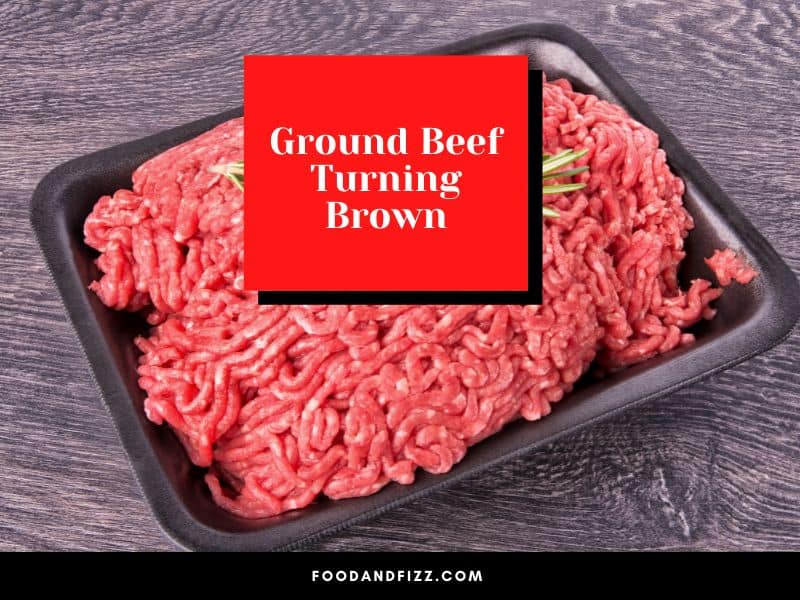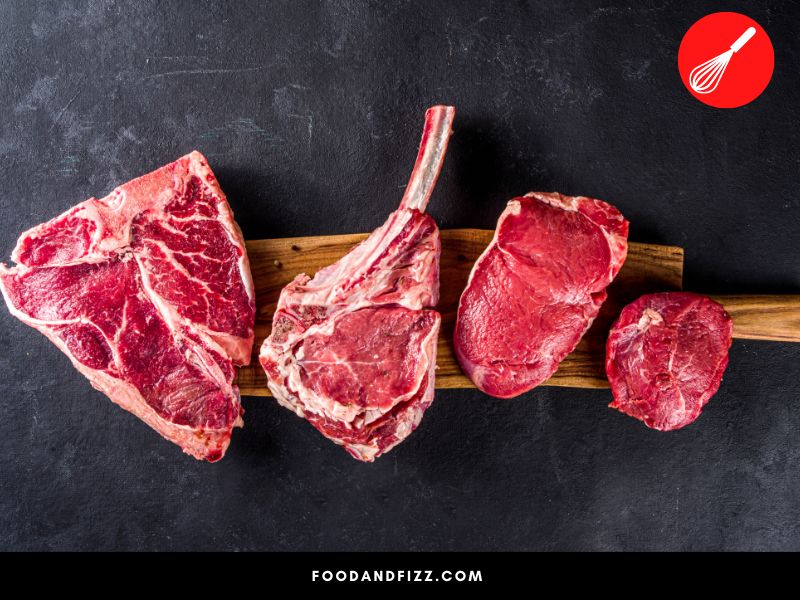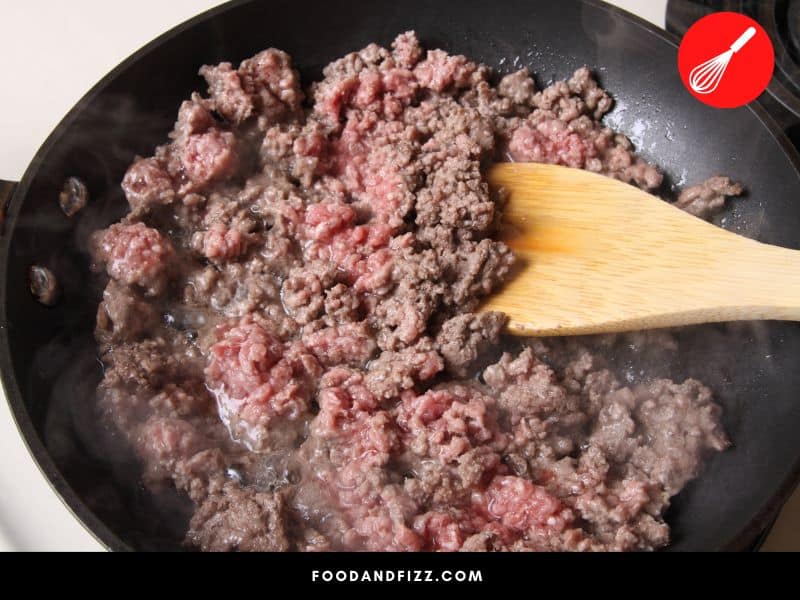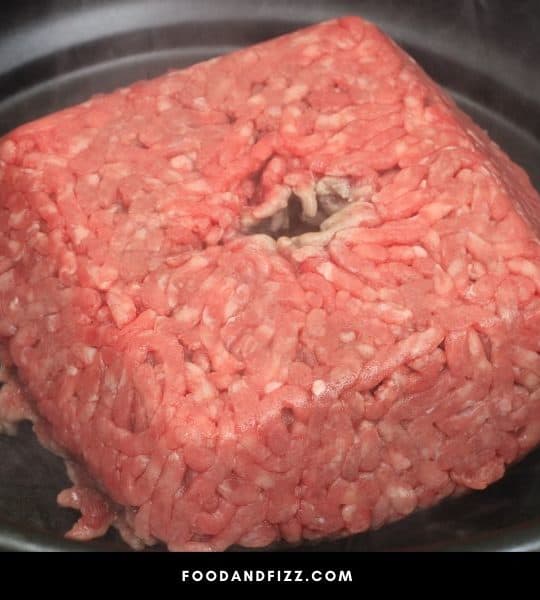Fresh ground beef is typically pinkish or reddish in color. So when we find ourselves face to face with ground beef that has shades of brown in it, it is natural to question whether it is still good to eat. Browning in ground beef can’t be a good thing, right?
Read on to find out.
Is Ground Beef Turning Brown Safe to Eat?
Ground beef that is turning brown is going through the process of oxidation. Prolonged exposure to air causes the pigments in meat to break down and change from bright red to brown. This color change is normal and does not necessarily indicate that the beef is spoiled, however, it is best to check the meat for any unusual growths, off-odors, and textures to make sure it is still good to eat.

Why Is My Ground Beef Turning Brown?
The color of your ground beef, and meat in general, depends on the action of a highly pigmented, iron-containing protein called myoglobin.
Myoglobin is what is responsible for supplying oxygen to the muscles, and is what is responsible for giving the meat its characteristic red color. It is similar to what hemoglobin does for our blood cells. The interaction of myoglobin that is present in the meat with the presence or absence of oxygen determines what color your meat will be.
It typically has nothing to do with the process of spoilage although sometimes, when meat has been stored for too long, this color change goes hand in hand with other signs of meat spoilage such as a slimy texture, foul odor, and strange growths.
Myoglobin can appear as three different colors depending on how your ground beef was packaged and its exposure to oxygen.
1. Purple-Red
When no oxygen is present, the myoglobin in meat takes on a dark purple-red color. Myoglobin in this state is called deoxymyoglobin. This color is typical of meat that has just been sliced, and meat that has been vacuum-packed.
2. Bright Red
When oxygen is introduced, typically within a few minutes of slicing or cutting the meat or exposing it to air, the iron in the myoglobin binds with the oxygen and transforms it into a bright shade of cherry red, in a process that’s known as “blooming”.
Myoglobin in this state is known as oxymyoglobin. This color is what we usually associate with “fresh” meat, and what most consumers typically look out for in buying meat.

3. Tan or Brown
When there is very little oxygen in the package, such as when meat is stacked with each other, it can cause them to turn brown.
Also, when the iron in the myoglobin has exhausted its ability to bind with oxygen molecules (such as later on in the meat’s lifespan), the meat’s color will also turn tan or brown.
Myoglobin in this state is called metmyoglobin. At this stage, the meat has likely oxidized, and while not necessarily spoiled at this point, it means that the meat has had prolonged exposure to oxygen and therefore may not be as fresh.
Ground beef that is turning brown has likely been packaged with very little oxygen, or has been oxidized and has had prolonged exposure to air. It does not necessarily mean that it is bad, but it may mean that the ground beef has been in storage for a long time, and thus may not be as fresh.
Is Ground Beef that is Turning Brown Safe to Eat?
While the color of the meat is important in determining freshness, ground beef that is turning brown does not necessarily mean that it is bad.
Ground beef that has gone bad will have a very foul and off-putting smell and a coated, slimy texture. It may also have unusual growths on the ground beef indicative of bacteria and pathogens, and may also change colors from brown to gray to green to other strange colors.
If your ground beef is turning brown but it does not have any other unusual appearance, smells okay, and feels okay, then it is safe to eat.
Your ground beef is likely just experiencing the normal process of oxidation. However, it is a good idea to use it up right away and not keep it in storage for very long as oxidation also means that the process of spoiling is not that far away.

How Long Does Ground Beef Last?
Ground beef may safely be kept in the fridge for about 1-2 days, while whole cuts of beef like steak usually last a few days longer.
Usually, ground meat has a shorter shelf life than whole cuts of meat. This is because in ground meat, there is more surface area for bacteria and pathogens to proliferate, and thus the process of food spoilage kicks in faster.
Your ground beef will last longer if you keep it in the freezer. The USDA says that ground beef will last indefinitely in the freezer, but recommends using it within 4 months for best quality.
In both the fridge and the freezer, make sure to properly wrap your ground beef and store them separately from other foods so that there will not be any cross-contamination.
Properly wrapping it in plastic wrap, foil, or storing it in airtight containers and freezer bags will keep freezer burn at bay and allow it to retain its taste and texture for a longer period of time.
How Do I Know That My Ground Beef Has Gone Bad?
If your package of ground beef is already bad and unsafe to eat, there will be obvious signs. So how do you know that it’s time to throw away that package of ground beef?
1. Appearance
Ground beef that has gone bad may have unusual growths like mold on the surface and may turn a different color like gray or dull brown. If your ground beef does not have any mold and has just turned a brown color, it may not necessarily be spoiled.
Brown ground beef does not automatically equal to spoilage although it definitely indicates that the ground beef is not as fresh as it should be, and may be further along in its lifespan. At this point, proceed with caution and check for other signs of spoilage.

2. Odor
Ground beef that is unfit for consumption will definitely have a foul odor, like that of ammonia or sulfur, aka rotting eggs. Fresh ground beef does not smell of anything except meat.
If it has developed a strong, unusual odor, do not consume it as it means it has gone bad.
3. Consistency and Texture
Fresh ground beef will have a firm texture and when you squeeze it, it will break apart quite easily. Ground beef that has spoiled will be sticky and tacky and have a slimy texture.
It may feel like it’s coated with something oily and sticky. If your ground beef has this consistency, it is time to toss it out.
4. Storage and Handling
Ground beef can only be stored in the fridge for 1-2 days. After that, it may not be safe to eat anymore as pathogens and bacteria may already have proliferated in the meat, even if you see no visible signs.
If you know that your ground beef has been sitting in your fridge for longer than two days, it may not be a good idea to eat it.
Also, if your package of ground beef was left at room temperature for more than two hours, it may be too risky to consume.
This is because it has been left out in the food danger zone beyond the prescribed safe period. Bacteria thrives and proliferates rapidly in these unsafe temperatures, often exponentially.
It’s wise to just toss it out rather than risk getting sick.
5. Expiration Dates
Some types of food can be safely consumed a few days past the expiration date with no harm done, but I wouldn’t advise doing that with meat products.
The risk of contracting a potentially serious type of food-borne illness is just too big. If your package of ground beef is past its expiration date, it’s best to just move on and discard it.
If you are unsure as to the freshness of your ground beef, it is best discarded rather than consumed. It may seem wasteful to toss meat out especially when you do not see any visible signs that your ground beef may be past its prime.
However, it is the most prudent thing to do especially since bacteria and pathogens are not things we can readily see, and the toxins they produce that are invisible to us cannot be neutralized with cooking.
Your health is worth far more than any package of ground beef.
What Happens When I Eat Ground Beef That Is Bad?
If you eat ground beef that has gone bad, you will likely contract a food-borne illness, also known as food poisoning.
Some symptoms of food poisoning include:
- Fever
- Nausea
- Diarrhea
- Vomiting
- Headaches
- Dizziness
- Abdominal Pain
- Upset Stomach
Many cases resolve from a few hours to a few days but some persist for weeks, and months, and may even require hospitalization and in some cases, may be life-threatening as well.
Depending on the type of toxin ingested, it can also cause long-term effects like arthritis and kidney issues. It just isn’t worth taking that risk.
Why Did My Ground Beef Turn Brown When I Cooked It?
Ground beef that has turned brown while cooking can be attributed to two things – the breakdown of myoglobin and the Maillard reaction.
1. Breakdown of Myoglobin
When meat is subjected to heat, the myoglobin also reacts to this change in temperature. At internal temperatures of above 140 °F, the myoglobin denatures and breaks down, and it becomes unable to bind with oxygen, resulting in brownish, tan-colored meat. The compound that brings about this change is what is called hemichrome.
Below 140 °F, the myoglobin remains unaffected, which is why rare beef is pinkish to reddish in color. As the temperature increases, the concentration of hemichrome increases, and at temperatures of 170 °F and above, myoglobin begins to convert to metmyoglobin, which as we mentioned in the earlier section, turns the meat brown.
This is why as you cook your ground beef, it a turns darker shade of brown. This typically happens faster in ground beef as there is more surface area for heat permeation.

2. Maillard Reaction
In simple terms, the Maillard reaction is what happens when proteins, carbohydrates (sugars), and heat interact. This interaction causes food to turn brown.
It is typically desired because aside from the appetizing aesthetic it provides, it also causes the development of certain flavor compounds that intensify the flavor of the food.
Cooking meat triggers the Maillard reaction, as do toasting marshmallows, cooking French fries and grilling vegetables.
Your ground beef that is turning brown is also experiencing the Maillard reaction, in conjunction with the breakdown of myoglobin, as you cook it over the heat.
How Does Ground Beef Retain Its Fresh, Reddish Color?
Sometimes, certain things are added to meat to help it retain its “fresh” color. Since most consumers go by the color of meat when deciding to make a purchase, the color of the meat matters.
Myoglobin, when exposed to oxygen, takes on the form of oxymyoglobin, which makes meat a bright red color. However, this is not permanent. As it continues to be exposed to oxygen, it will eventually turn brown due to oxidation.
When carbon monoxide is added in small amounts to the meat or the packaging, the myoglobin binds with it more readily than oxygen, and transforms it to carboxymyoglobin.
Carboxymyoglobin resists oxidation more than oxymyoglobin, and thus it helps keep meat reddish or pinkish for longer.
It is actually pretty controversial, as who wants carbon monoxide in the food that we consume? Some groups have also said that it may mask the freshness of meat and mislead consumers, but the authorities have said that that is not the case.
Spoiled meat will be obvious regardless of its color, and the small amounts of carbon monoxide added is not unsafe to consume. You can read more about the controversy here.
This is why regardless of the color of the meat, we should always check the other important things to make sure we are consuming meat that is safe to eat.
Frequently Asked Questions to Ground Beef Turning Brown
Is It Bad if My Ground Beef Turned Brown in the Fridge?
Meat that has turned brown in the fridge is not necessarily bad, as color changes are natural as the meat is exposed to oxygen. As long as it does not have a foul odor, or slimy or sticky texture and was stored well and not past its expiry date, it is safe to eat.
Ground Beef Turned Brown After Thawing, Is it Still Good?
Ground beef that has turned brown after being frozen and thawed has likely changed colors due to the lack of or presence of oxygen, which transformed the form of the myoglobin, the protein responsible for the color of meat, into a brown shade. If there are no other signs of food spoilage, it should not be a cause for concern.
Conclusion to Ground Beef Turning Brown – What is It? Safe to Eat?
Ground beef turns brown mainly because of oxidation or prolonged exposure to oxygen. As long as there are no other signs of spoilage and as long as your ground beef was handled and stored properly and is not past its expiration date, it will be safe to consume.
Color is not always an indication that meat has gone bad, although your ground beef turning a brown color is an indication that it is further along in its lifespan, and not as fresh. It is a good idea to use it up right away and not store it for a longer time because while it is not there yet, it is well on its way to spoilage.

